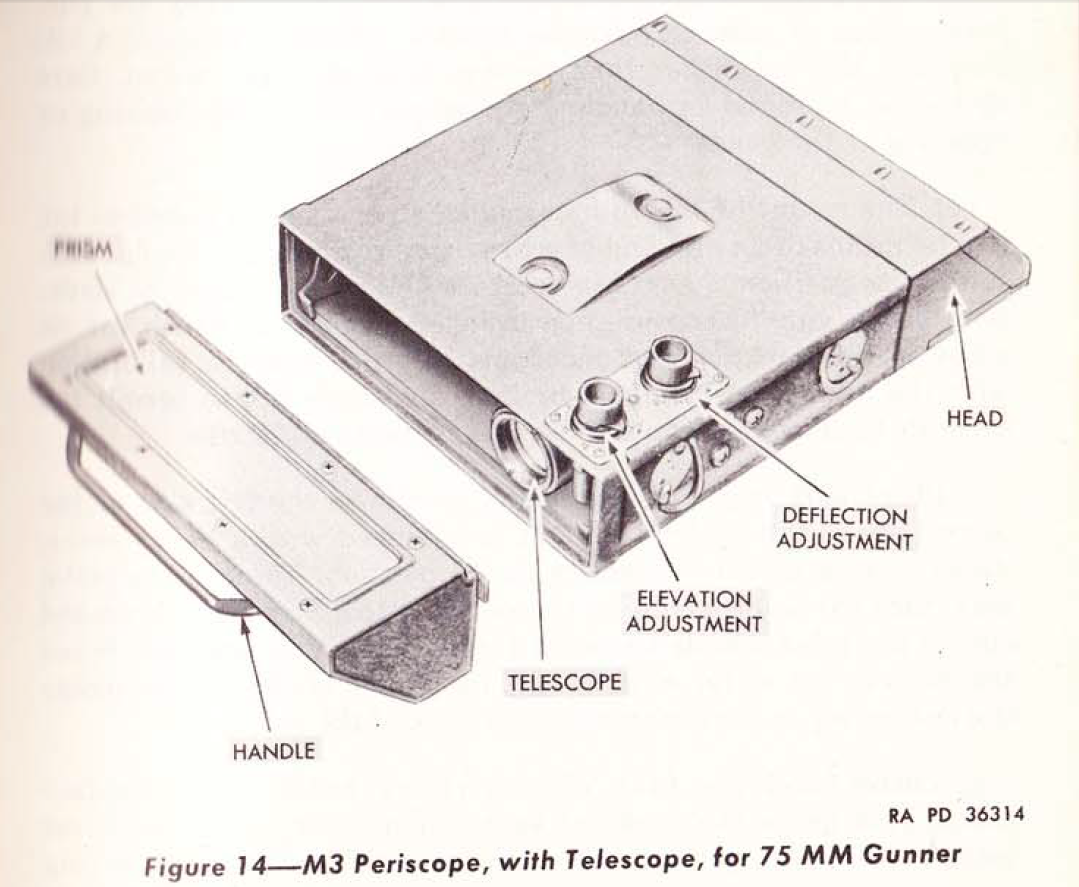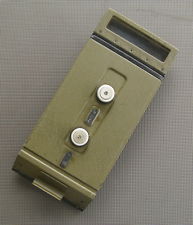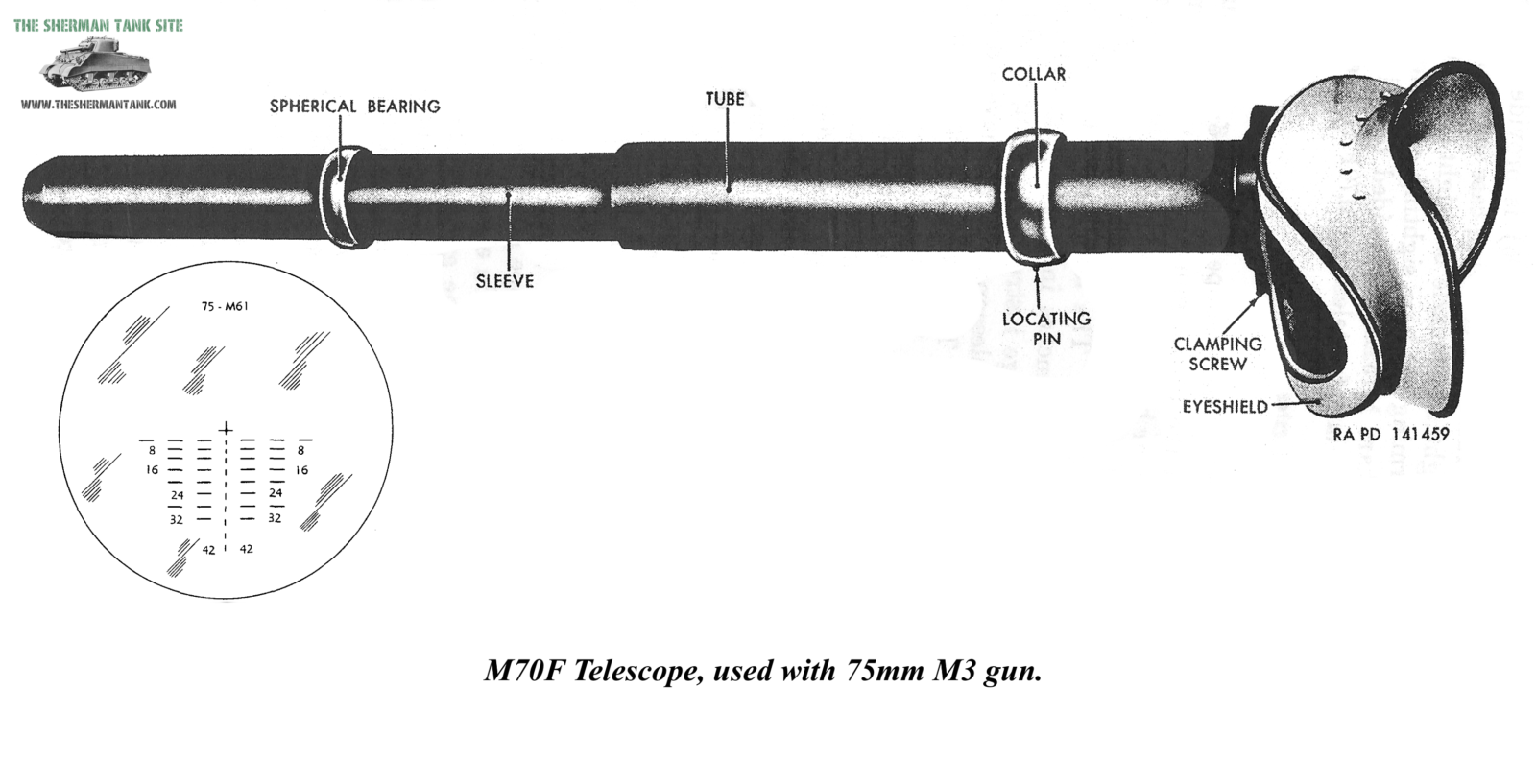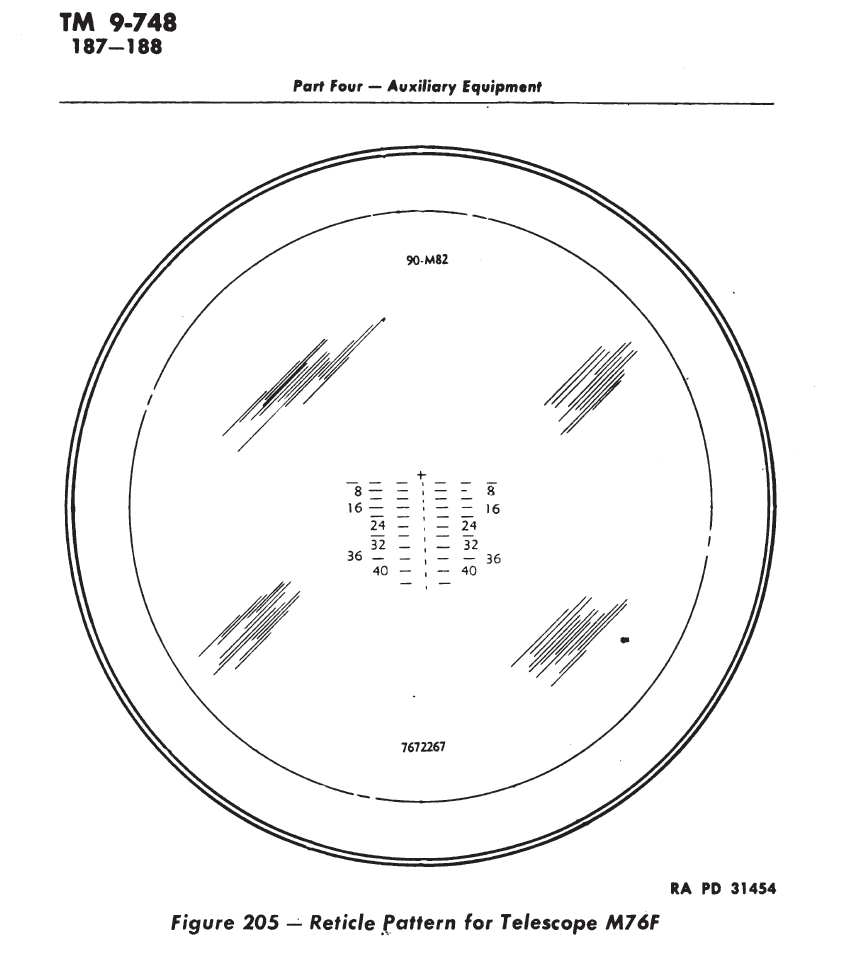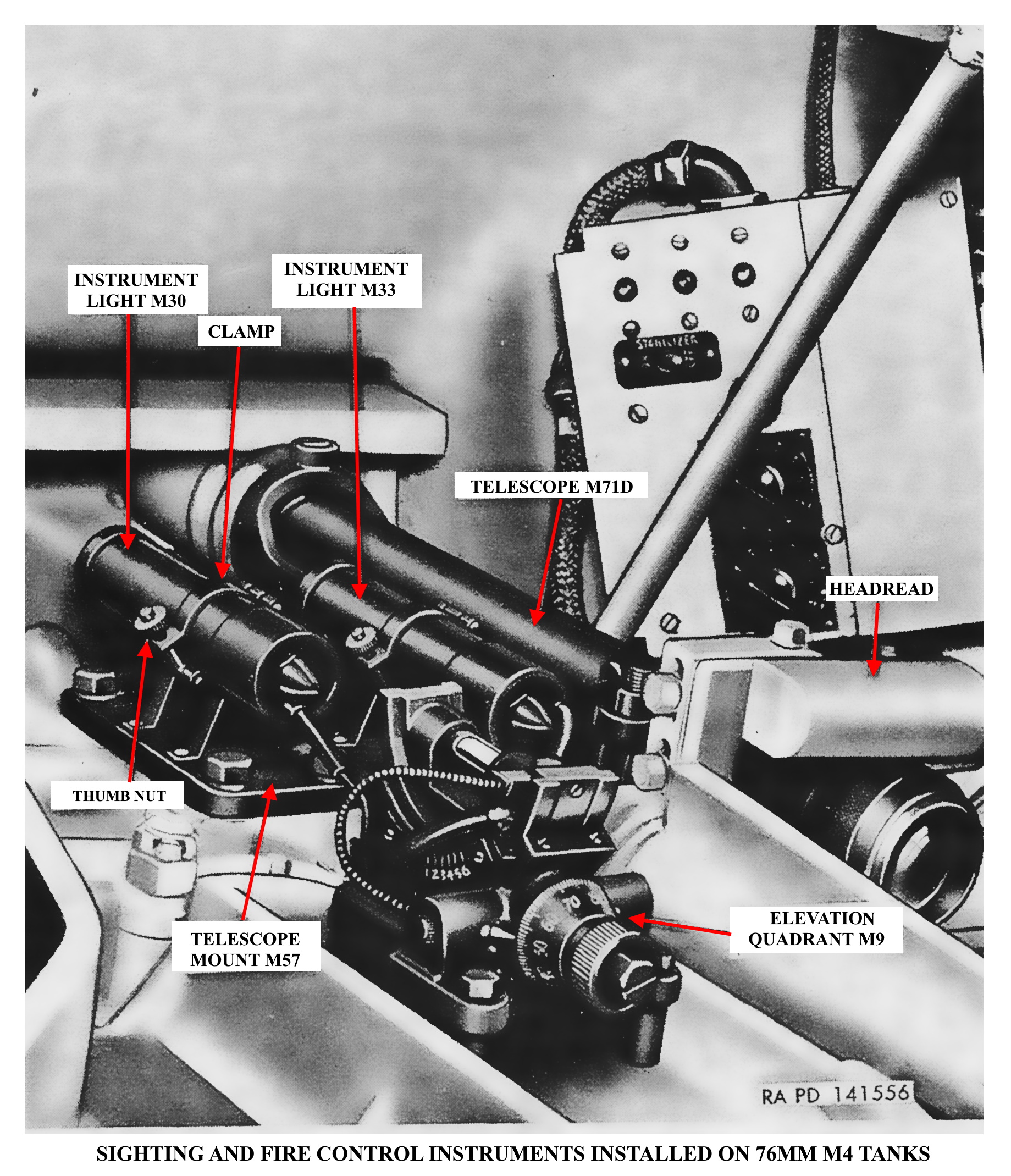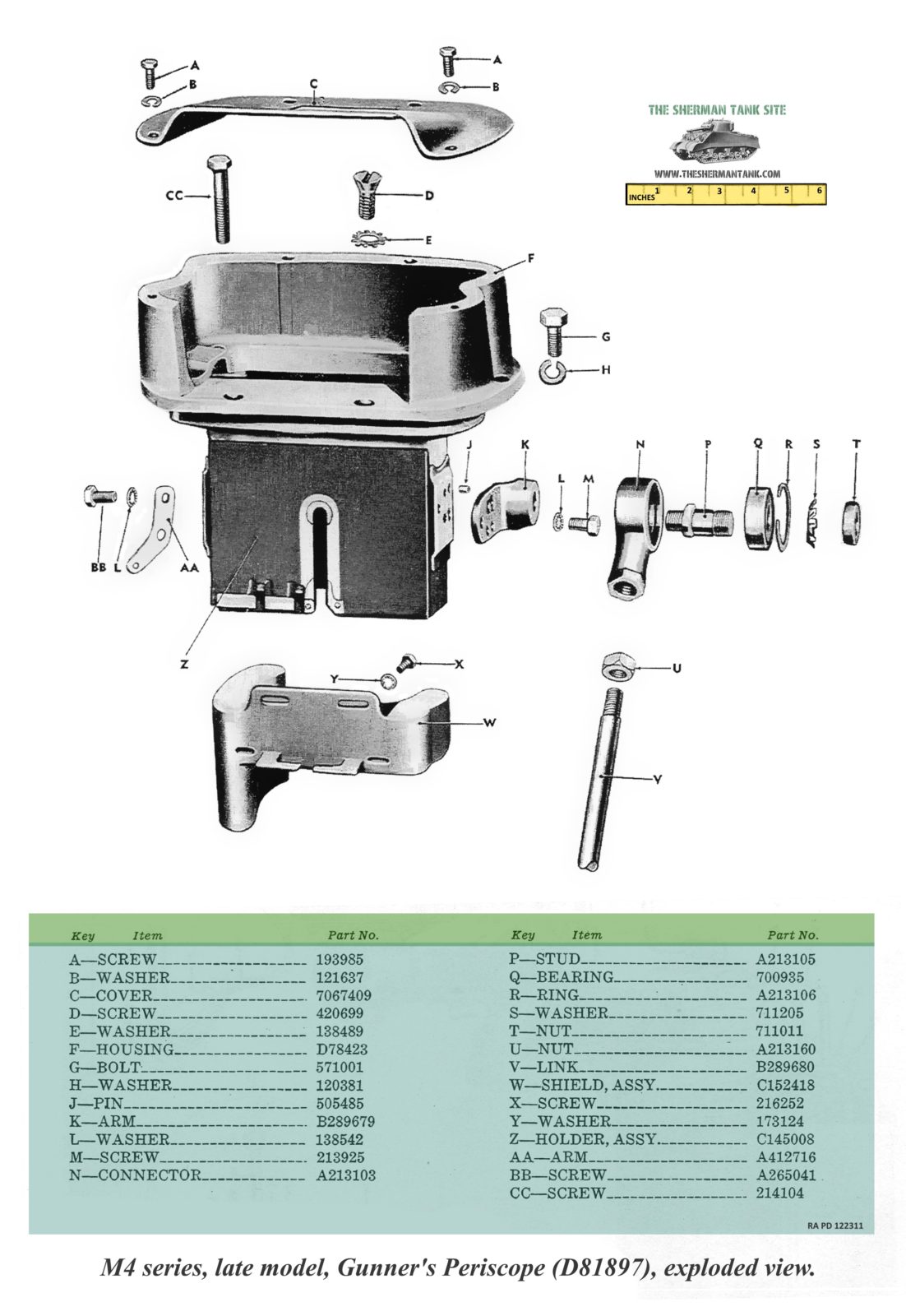 M4 Series Fire Control: Not putting out fires, what you look through when firing the guns!
M4 Series Fire Control: Not putting out fires, what you look through when firing the guns!
The Sherman tank went through a series of fire control changes, each an improvement over the last. The first tanks lacked telescopic sight mounted on the M34 gun mount. The only sight was incorporated into the gunner’s periscope, and it wasn’t magnified. Since the periscopes were all interchangeable, updating the older tanks was easy, at least where the periscope was concerned, adding a telescope was a little more complicated.
The final fire control setup the Sherman gunner had at his disposal in a mid to late-model Sherman was pretty impressive by the standards of the time. He was in a hydroelectrically driven turret that rotated fast; he had a very nice periscope setup with 1x and 6x scopes hooked into the gun with strong linkage. He also had a telescopic sight to work with, and the gun was stabilized. This was a vast improvement over the unmagnified reticle on the first production models. This, coupled with the Sherman’s comfortable design, made it a formidable weapon, even in amateur hands.
The Lee used a unique setup; the 75mm gun was aimed with an M1 periscope, with an M21A1 periscope built into the mount. The 37mm was aimed with an M2 periscope with an M19A1 periscope built into its mount. Both the 37 and 75 mounts were stabilized. The prototype M6 Sherman used its own unique sight built into the sight rotor on the top of the turret. This was only used on a small number of production Shermans tanks.
Let’s look at the various periscopes and telescopes the Sherman used throughout its long life. Let’s start with a look at the various versions of the periscope sights, the production Sherman and the TDs based on the chassis below.
The M3 Periscope Sight
Since I just have a little info on this from TM 9-731B in the early M4A2, I don’t have much to put here. Maybe this periscope is the one I’ve read about getting foggy on the inside in cold or humid locales. It was quickly replaced with the M4 detailed below. This was one of the non-magnified periscopes.
The M4 Periscope sight
The Periscope M4; it had an M38 telescope with ballistic reticle inside, but no magnification. The M4 was not well liked, and the mount it fit in was made from sheet metal and was a little flimsy. The linkage that attacked it to the gun wasn’t very robust and could be knocked out of alignment annoyingly easily. On early Shermans, this was a big complaint, since they did not have a direct telescope yet. You couldn’t really take advantage of the M3 75mm guns range with this sight setup either since it had no magnification. The later better periscopes like the M4A1 and M8 series would all fit in the old mount though.
I do not have a pic of the M4 periscope right now.
The M4A1 Periscope Sight
Next came an improved version of the M4, and the M4A1, and they came with an M38A2 telescope. This one was magnified, but not much at 1.44x, and a 9-degree field of view. Later versions of this periscope had illuminated reticles. The mount was not improved though not the linkage. The M4A1 periscope was changed when the 105mm and 76mm armed Shermans came online when used with these guns. They had the M47A2 for the 76 tanks and M77C for the 105 tanks. Hunnicutt doesn’t specify if these were also 1.44X. This periscope was found on M4A1, A2, and A3 76 tanks during WWII.
The M8/M8A1 Periscope Sight
The M4A1 periscopes were replaced by the M8 and M8A1 periscopes. They were a larger tougher improvement on the M4 series and had the M39A2 telescopic reticle for use with the 76mm gun since it had the same reticle as the M47A2 used in the M4A1 periscope. The M39A2 had 1.8x magnification and a 6-degree FOV. Even though at this point, this was no longer the primary sight, the Army kept improving it. But the mount and linkage still remained an issue.
The M10 Periscope Sight series
The Army came up with another new periscope sight system called the M10. They started issuing it late in the war, around the same time wet tanks started appearing. This was a much-improved periscope; it incorporated two telescopes with reticles, one 1.x, with a field of view of 42 degrees, ten minutes for engaging close targets. The second periscope had a 6x telescope with an 11-degree 20-minute field view. When the right reticle was fitted, this periscope could be used with the 76, 75, and 105mm guns. There was also an M16 periscope, the same as the m10, but with a reticle adjusting system.
M10C was specific to 75mm Shermans.
M10D was used on 76mm tanks and 105 tanks.
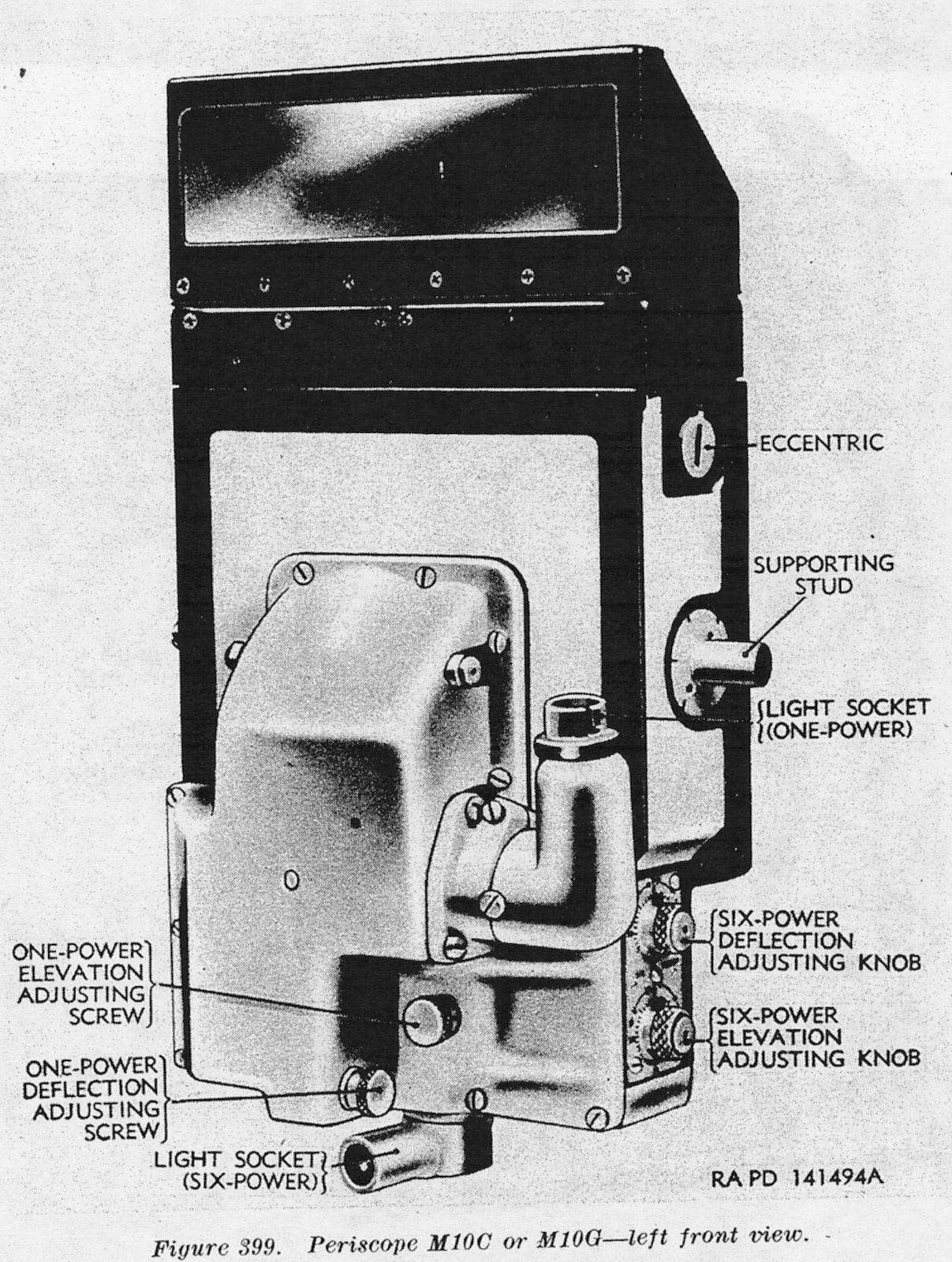

The Periscope mount
for these periscopes were improved greatly when the 76mm gun and 105 tanks arrived, and the mount was made from a beefy casting, and all the linkage was made much stronger will ball bearing in all the pivot points. These would have shown up on M4A1 75w, M4A3 75w, M4A3 105, M4 105, and M4A3 76w, M4A2 76w and M4A1 76w tanks.
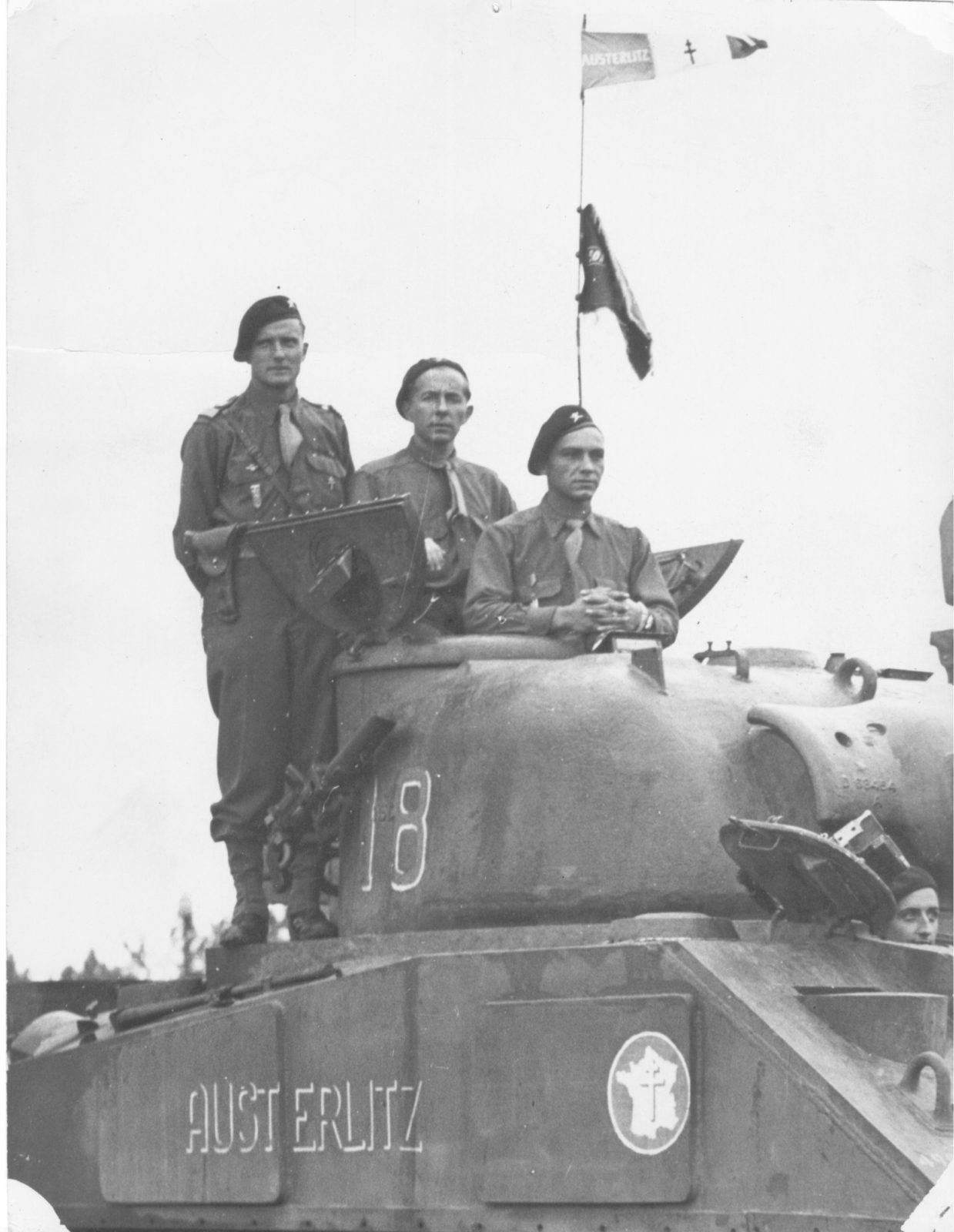
This improved mount was also incorporated into most of the post-war rebuilds and overhauls. It is very easy to spot by the heavy cast steel hood over the periscope hole.
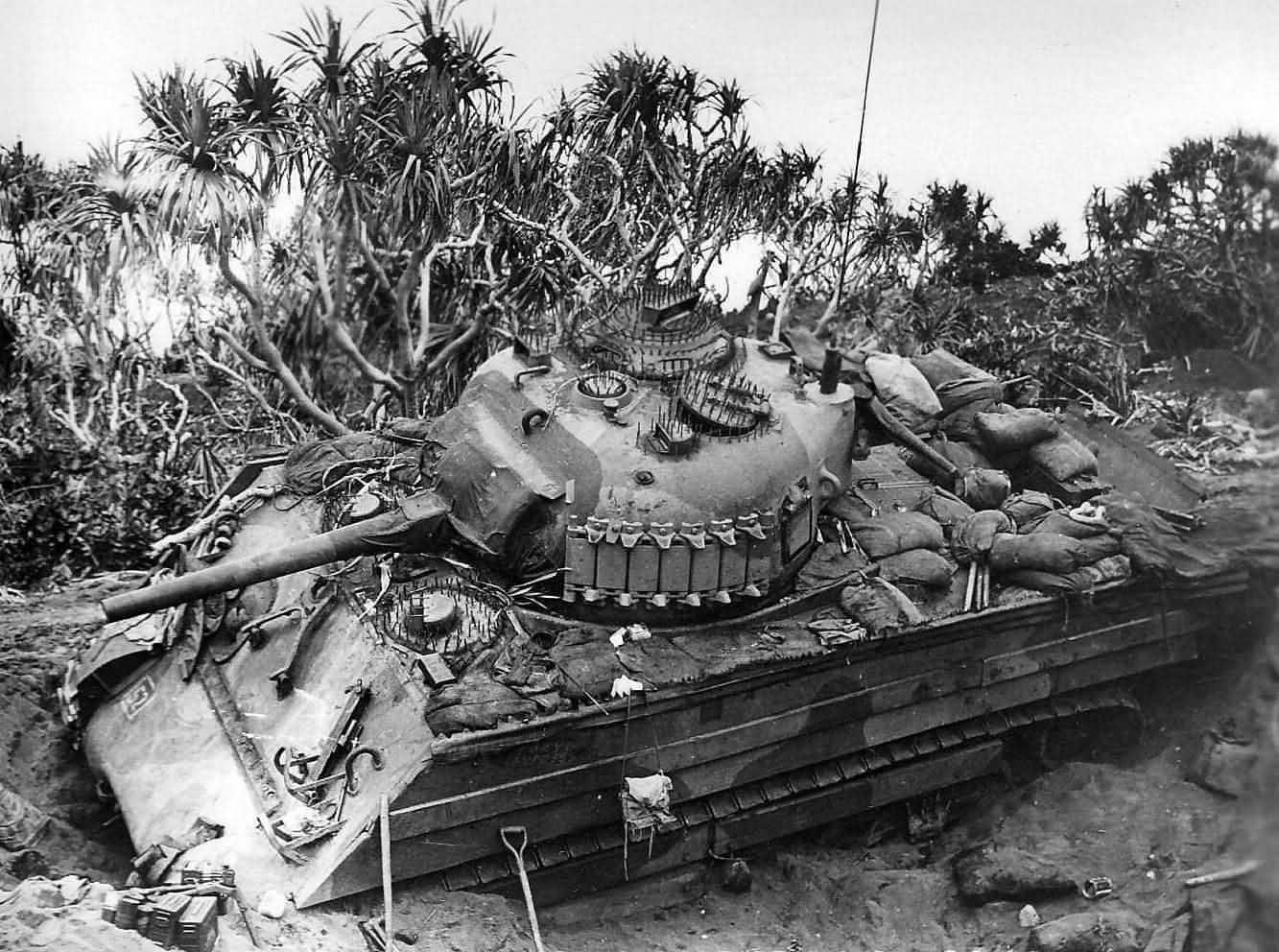
The Telescopic sights.
The Shermans fire control system was improved further by the incorporation of a direct telescope mount to the M38A1 gun mount. This prompted the creation of the full-length gun mantlet to protect the scope. When these were retrofitted into older tanks, sometimes they would weld on armor over the scope, leaving a half armored mantlet.
The later 76mm armed tanks had the M62 mount, and it had a telescopic sight mount from the start.
The direct scopes went through their own evolution, and this information is put together from the various TMs on the tanks and Hunnicutt’s Sherman and is not complete. I will update this section as I get more info on the topic.
The M55 Telescope: The first! For the 75mm and 105
This telescope had 3x magnifications with 12 degrees 19-minute FOV. This sight was also used in the early production 105 tanks and most 75mm Shermans.
The M51: Also the First, but for the 76 M1A1
The same scope as above, with the same specs, but with the reticle for the 76mm guns, and that’s all. There were complaints about the optical quality on these scopes since the clarity wasn’t optimal.
M70 Telescopic Sight Series
The M50 sights were replaced with the M70 Series sights, the same size, and magnification. What set them apart was there superior optical quality. The Army went on to develop many different versions of this sight. It was a 3X scope with a 12 degree 19-minute FOV.
M70F Telescopic Sight
This was version used on M4A3 75W Shermans.
M70G Telescopic Sight
This sight was used on M10 GMC tank destroyers.
M70P Telescopic Sight
This sight was used on some M36 CMCs tank destroyers.
M71D Telescopic Sight
This was a 5x with a 13-degree FOV version of the scope. It had the reticle for the 76mm guns and was used on those tanks. This was the sight commonly found on M4A1 and M4A2 76 tanks.
M71G Telescopic Sight
This version of the M71 was issued with the Jumbo tanks.
M72D Telescopic Sight
This was used on the 105mm armed Shermans.
M76F/D Telescopic Sight
These telescopes were used on the M36 GMC tank destroyers.
M76G Telescopic Sight
This scope only had a 3x magnification, with a 21 degree, 30 minutes FOV, and was used in 105 tank applications later in the war.
M83 Veritable Power Telescopic Sight.
This scope had two settings, 4x 7 degrees, 40 minutes and 8x 4 degrees, 15 minutes, and M83D version of this sight worked with the 76mm guns when in an M62 mount. I have not seen this one mentioned anywhere but Hunnicutt’s Sherman book. That doesn’t mean it didn’t get issued as a replacement later in the war since I’m going off TM’s and spec sheets and those are a small snapshot of a tanks actual combat gear.
♠♠♠
Indirect Fire Control Gear
You would think that would be it for fire control equipment, but it’s not because all Shermans came equipped with the equipment for their tanks to work as impromptu artillery batteries all Sherman based TDs had this gear as well. The US Army had this extra gear installed all the way up to the M60 tanks. During the war, some tank and TD battalions were very good at being artillery; other units didn’t train for it and were not good. This was a good way of keeping tanks useful in Italy, and they filled this role a lot there. I do not think this was something many other nations did with their tanks.
Azimuth Indicator M19
The Azimuth Indicator was mounted near the gunner, right behind the traverse control. This device was used to dial in what direction the gun needed to be pointed in to carry out the fire mission.
Gunners Quadrant M1
The Gunners quadrant is a portable precision instrument used for measuring the elevation or depression angles of guns and howitzers. It can also be used for checking the adjusting of elevation devices on sighting equipment furnished with a gun or howitzer. This was taken right from the Characteristics in tech manual 9-1527.
Elevation Quadrant M9
The Elevation Quadrant M9 was used to lay the tanks main gun in elevation for indirect fire. There are detailed instructions for setting it up in TM 9-748.
A Sherman unit trained in how to act as an artillery battery would probably be told they were on call when not in direct combat but close enough for the 75s to reach. They would have men manning radios in the tanks while other tasks were being done, like maintenance, personal things, and eating. When they got the call, the designated battery commander for each platoon would listen to the directions on the arty net or get in direct contact with the spotter. In many cases they would be wired into the net directly, so they wouldn’t need to worry about radio reception. They would relay the aiming information out to the tanks on the radio or phone net and then they would start firing.
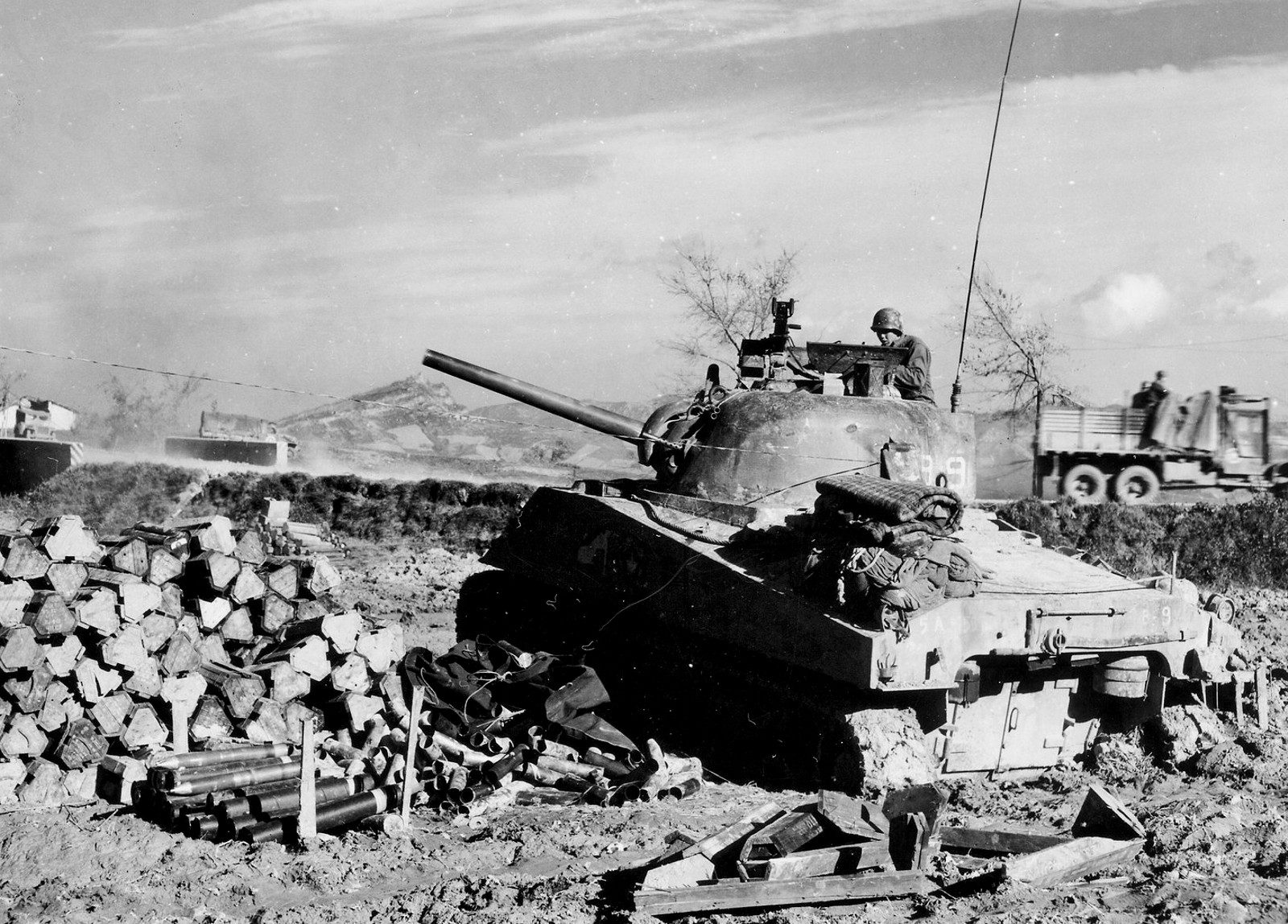
Once they started firing the whole crew would help feed the gun, and if they were doing it as a common thing they might even have large amounts of ammo unboxed outside the tank, where the driver and co-driver could feed them to the commander who then fed them to the loader. The M3 75mm gun worked well in this role since the barrel had a life in excess of 4000 rounds.
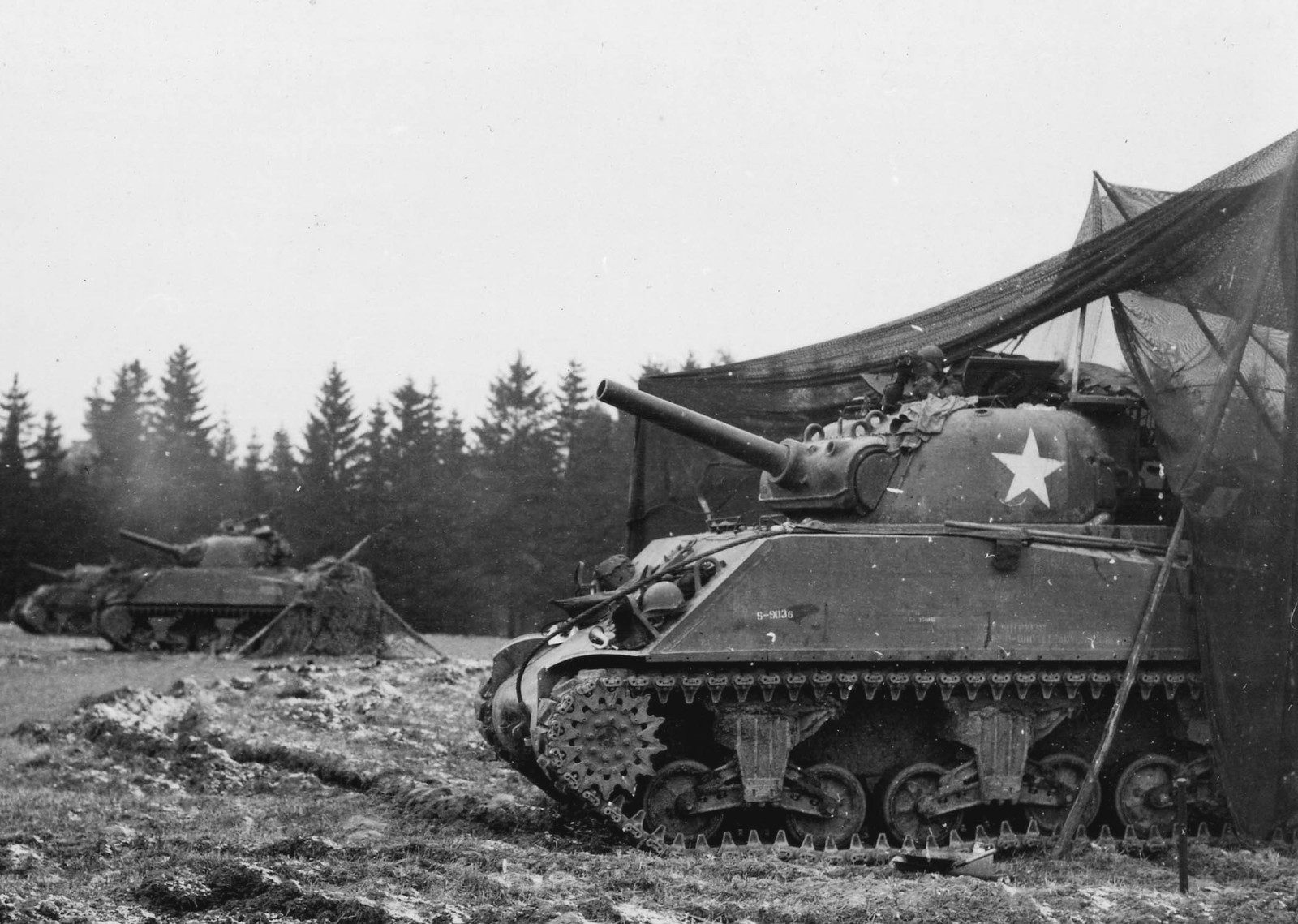
Sources: Sherman by R.P. Hunnicutt, TM9-731b, TM9-731G, TM9-748, TM9-748, TM9-750, TM9-752, TM9-754, TM9-759
